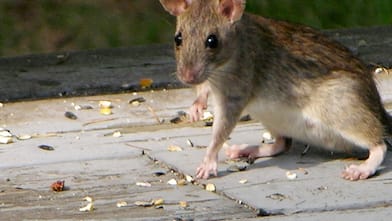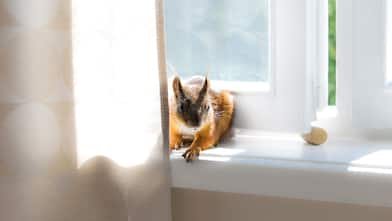Highlights
Groundhogs may burrow into your yard looking for food and shelter.
A groundhog can eat about 1 pound of food per day.
You can try to repel groundhogs with scent, sound, and motion.
Trap-and-release is an effective, long-term solution.
After removing the pests, you’ll need to take steps to prevent them in the future.
While Groundhog Day is a fun and silly tradition, a groundhog party in your garden is the last thing you want. These rodents can tear up your lawn and devour your precious plants, whether it’s a garden full of flowers or veggies. If you’ve found tunnels, soil mounds, and gnawed-up plants in your yard, here’s how to get rid of groundhogs for good.
What Is a Groundhog?
You probably love groundhogs when they are predicting an early spring, but less so when they gnaw their way through your vegetable garden. Also known as woodchucks, groundhogs are a type of rodent that burrows for food and shelter. Although they measure less than 2 feet long and weigh just 8 to 12 pounds, they can eat about 1 pound of food per day.
Why Are Groundhogs in Your Yard?
Groundhogs eat a lot of food per day, and they aren’t too picky. These critters will eat vegetables, grasses, twigs, flowers, and bugs, so your veggie garden or lush landscape are one big buffet for these rodents.
These creatures also rely on burrowing for shelter, where they may store food and nest. They can dig complex tunnel systems, but that leads to weak soil that can destroy your yard and even damage structural foundations, walkways, driveways, and other landscaping and hardscaping.
Signs of Groundhogs in the Yard
If your plants look chewed up or that zucchini you were waiting to pick at just the right moment has suddenly disappeared, you may be dealing with groundhogs. Another telltale sign is tunnels or mounds around the yard. Groundhog tunnels are about 10 to 12 inches wide, and you’ll typically see a few of their tunnel entrances around your property.
How to Get Rid of Groundhogs
If you notice signs of groundhogs in your yard, you’ll want to get to work right away on getting rid of these animals. The longer you wait, the more damage they can do above and below ground.
1. Make Groundhog Repellents
From spicy peppers to garlic, there are several homemade wildlife remedies that can send groundhogs packing. They may also feel threatened by fur and urine of other animals, too.
Sprinkle red pepper, talcum powder, or garlic around the garden.
Blood meal may also deter groundhogs while also benefiting the plants.
Scatter hair clippings or pet fur around the yard.
Soak cloths in ammonia, then place them around the garden.
When they are not in their burrows, pour castor oil around the tunnel entrances.
Place clumps of kitty litter with cat urine right inside a tunnel entrance.
2. Scare Them Off
Groundhogs aren’t likely to hang around if they feel threatened, so consider pinwheels or wind chimes to deter them. You can also find ultrasonic devices that send vibrations underground to scare off the groundhogs. Noise and motion deterrents aren’t a great long-term solution, but they might keep groundhogs away until you can establish a more permanent option, such as installing a fence or hiring animal control services.
3. Fence Off the Garden

If you want to keep these pests out of the garden, install a fence around your flowers or vegetables. Make sure the fence is at least 1 foot underground to keep the groundhogs from burrowing under it. Choose a fence that is at least 3 feet high, too, or they can hop right over it.
4. Trap and Release
Trapping and releasing these animals is an effective and humane option. It’s best to hire an animal control service to safely trap and release them. If you try to DIY groundhog removal, avoid touching the creatures to minimize risk of diseases like Lyme disease, rabies, or tularemia. Also, you’ll need to release groundhogs up to 100 miles from their burrows, or they might return.
How to Prevent Groundhogs in the Future
Whether you’ve eradicated the groundhogs taking over your yard and want to keep them from coming back or you’ve just planted a veggie garden and don’t want to deal with these rodents at all, here are some common ways to keep groundhogs away from your lawn and garden.
1. Get Rid of Nesting Spots
Although they like to tunnel underground for shelter, a stack of wood is also a cozy, inviting place for groundhogs to nest. Make sure to clear out any woodpiles that could become a nesting site for these pests.
2. Close Off Old Tunnels
Even if you trap and relocate a groundhog, another one may come to your yard to take advantage of the empty tunnels. Dig out about 1 foot deep into the tunnel, then place a 3-square-foot wire panel over the tunnel entrance. Cover it with soil to close off the hole.
3. Maintain Your Lawn and Garden
Your landscape is a lot less attractive to hungry groundhogs when there’s not much to eat. Make sure to rake up debris, like leaves and twigs. If you grow produce, harvest as much as you can each day to get to the food before the groundhogs do.
4. Plant a Groundhog Garden
This method is a bit of a gamble, but if you just can’t stomach moving these creatures from your yard to another random location, you can try to deter them from destroying your garden by giving them their own. Create a small garden full of groundhog favorites, like clover, alfalfa, peas, or leafy greens, near their tunnel entrance.
How Much Does Groundhog Removal Cost?
Professional groundhog removal costs about $150 to $200, depending on the type of removal and how many groundhogs are in the yard. Trapping, transport, and relocation of groundhogs is usually a more expensive option, but it’s a more humane way to deal with groundhogs compared to extermination. Hire a local animal removal technician to safely and efficiently deal with groundhogs before they tear up your lawn and garden.





